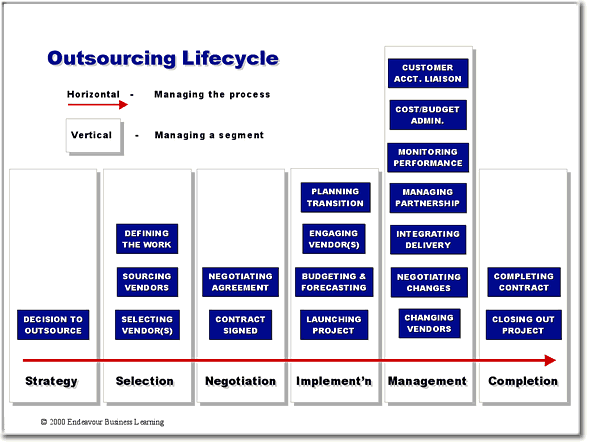Outsourcing Phases
1 – Strategy
A decision to outsource is suggested, reviewed and evaluated. It may be part of a larger strategy to move the company to a leveraged business model and to focus on core competencies. It may be strictly a decision to outsource a particular function, operation, program or project. Typically, the strategy is developed at senior levels within the company.
2 – Selection
This critical phase covers the definition of the work to be outsourced, as well as the sourcing of the vendors using a Request for Information (RFI) and/or Request for Proposal (RFP) process, and finally making the selection of the "best-fit" vendor. There are three major processes in the selection phase:
- Defining the work
- Sourcing the vendors
- Selecting the vendor or vendors
3 – Negotiation
This phase is comprised of two major processes:
- Negotiating the contracts and associated agreements, and
- Signing the final contract
Often this phase is completed after the implementation phase has begun, as both the company and the vendor may have extensive legal review processes. A memorandum or letter of understanding may be put in place until the final contract has been signed.
4 – Implementation
This phase involves the start-up activities of planning the transition and implementation of the outsourced agreement, as well as establishing the administrative functions needed for its management, and the formal launching. The four major processes in the implementation phase are:
- Planning the transition
- Engaging the vendor or vendors
- Preparing the detailed budgets and forecasts
- Launching the program
5 – Management
The management phase encompasses all ongoing activities required to manage the project, and successfully achieve the contracted results. Each of the seven major processes listed below continues for the life of the project:
- Managing the customer (or user) relationship
- Performing all project financial oversight
- Monitoring project and vendor performance
- Managing the partnership or vendor relationship
- Integrating the delivery of service
- Negotiating changes in the project
- Overseeing the transition of vendors (both planned and unexpected)
6 – Completion
The final phase covers all completion and close out activities for the project. The two major processes in the completion phase are:
- Completing the contract
- Closing out the project
Outsourcing Management
Depending on the size of the outsourcing project, the manager responsible for the project's delivery and integration may be responsible for all of the processes, or only some of them. These are the horizontal and vertical factors of outsourcing management.
A manager of the horizontal process is often involved in the decision to outsource, and is then responsible for defining the work, selecting and engaging the vendor, and managing the delivery and completion of the project. This manager normally handles all day-to-day negotiations.
With larger projects or programs, particularly those on a global scale, there is often a decision taken at senior levels to outsource. A negotiation team is appointed to work through the complex agreements, usually under strict confidentiality, until the agreement is finalized and announced.
It is then the role of the manager of the vertical component to implement and manage the ongoing program. Part of this role is the interpretation of the agreement, and identification of areas not covered by the agreement.
Read our extended article "Who Controls Sourcing?"
Summary
Understanding the full outsourcing lifecycle and each of its phases will assist both companies embarking on outsourcing for the first time, as well as managers who need to determine their roles and responsibilities in the context of the specific outsourced programs.
Use this framework to help confirm that all processes and phases have been addressed, or identify any gaps or missing processes that need to be included in the planning of your next outsourced program.
|


